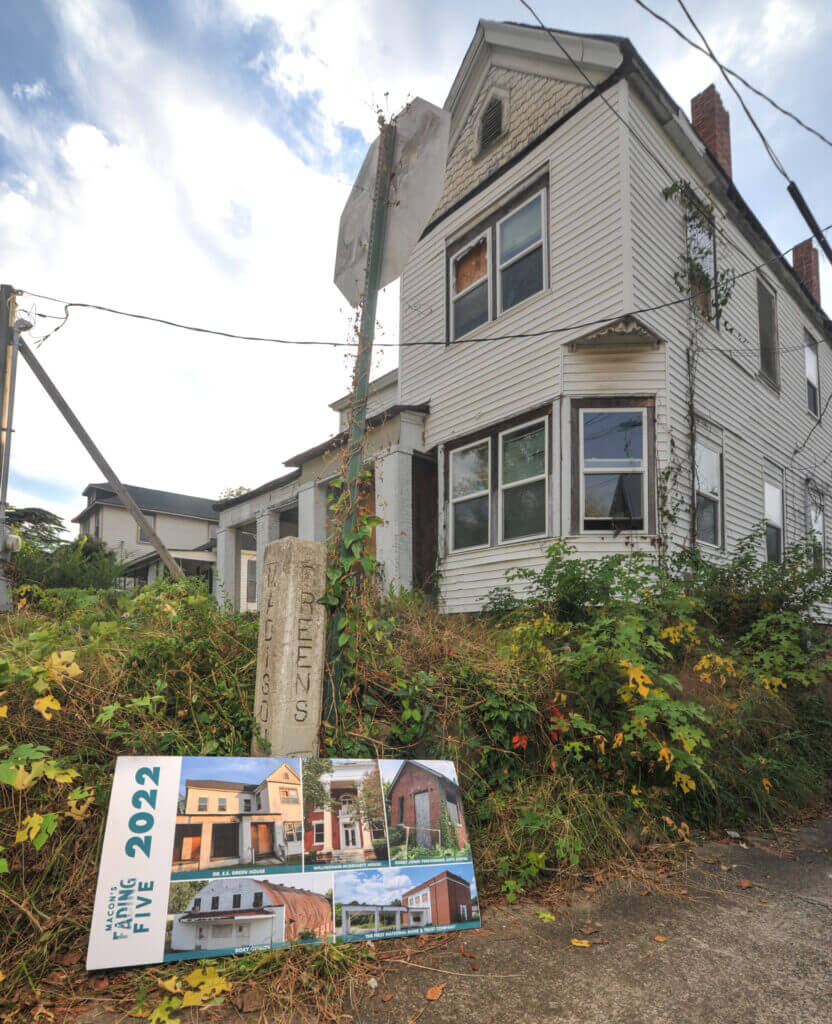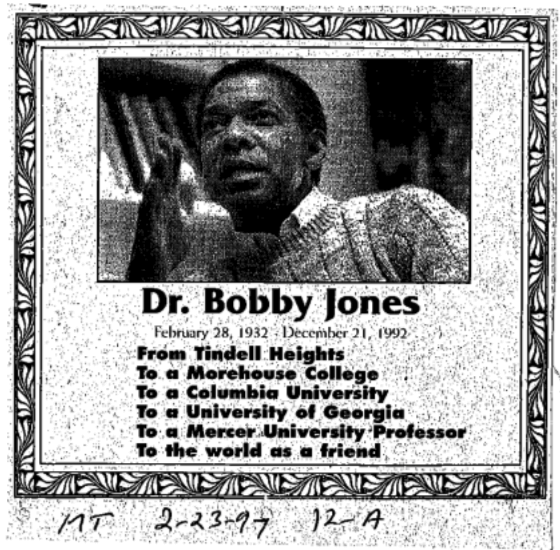
Championing the cause of heritage
The legacy of two men from Pleasant Hill echoes in the buildings that bear their names, which contemporary activists in Macon hope to save.
by George Fadil Muhammad
Photography by Dsto Moore and Oby Brown. Historical photos courtesy of Macon Telegraph, Mercer University, and Middle Georgia Regional Library and sourced by Tonja Khabir.
Despite over 200 years of poverty, tragic violence, education and health adversities, and the ravages and exploitations of racism, Black citizens of Macon yet possess an ancestral heritage of astounding natural excellence to draw from. Only a few historic buildings stand in Fort Hill, Unionville, Downtown Macon, and Pleasant Hill, reminders of extraordinary seasons of brilliant Black achievers.
The demand now resounds for a new Black success, a new Macon success, for our community to awaken and champion Black Macon’s value, power, and proper priority. An important step toward resurrecting our traditions of greatness is to preserve and establish the purposeful reengagement of such meaningful structures of triumph to serve as inspiration for present and future generations.
Two of the few remaining historical places of treasured heritage in southeast Pleasant Hill, just around the corner from one another, pay homage to community service luminaries Dr. Eustace Edward Green and Dr. Bobby Jones: The Green House and The Bobby Jones Performing Arts Center. Both leaders exemplified the invaluable traits of skill, knowledge, and generosity in their personal outreach to cultivate communities.
The historic structures named for these men have become publicly recognized in recent years, as evidenced by their designation as preservation sites by the Historic Macon Foundation’s Fading Five program. Since the launch of Macon’s Fading Five in 2015, Historic Macon has put 18 properties on the list. By creating a strategic preservation plan for each of the listed properties, 12 of them have been saved and protected, while just one Fading Five property has been lost.

The Green House was recognized in April in the Grand Opera House’s interactive history play about the past, present, and future of Pleasant Hill titled Healing a Haunted House, and the performing arts center building was highlighted for many years on Juneteenth Black History Tours hosted by the Bobby Jones Center.
Dr. E.E. Green was an outstanding academic born enslaved in 1845 in Wilmington, North Carolina, freed at age 20 after the Union Army’s arrival there at the end of the Civil War. As someone whose home city was the site of one of the worst race riots in US history in 1898 and a subsequent mass exodus of Black people, Green was acutely aware of the urgent conditions of his times and his people.
He was educated at the historically Black college and university (HBCU) Lincoln University, where he earned his undergraduate and master’s degrees. He then completed certification as a medical doctor at age 41 from Howard University Medical School. After obtaining his M.D., he moved to Macon.
The Green House is a two-story structure at the corner of Madison Street and Green Street Lane built by Green in 1890. It was here that he raised his family and, after a few years of operating the Central City Drug Store on Cotton Avenue, moved his pharmacy into the home. Green’s influence and property ownership led to the naming of the street next to his house as “Green’s Lane,” which can still be seen on the street corner. As one of the Pleasant Hill neighborhood’s early pillars, he was involved in civic affairs, a proponent of educational achievement and intellectual engagement by being a founding member of the Colored Medical Association and the National Medical Association, and a prayerful member of Washington Avenue Presbyterian Church. He was also a prolific mentor, notable for tutoring Henry Rutherford Butler, who established himself in Atlanta as the first Black person to receive a pharmacy license in Georgia. Green is buried in Pleasant Hill’s history-rich Linwood Cemetery.
Historic Macon Foundation Director Ethiel Garlington said he is personally excited about uplifting the legacy of the Green House. “We’ve only seen it from the outside and are eager to preserve it because of the amazing accomplishments of the man who lived there,” he said. Though the foundation has not been able to contact the current property owner, an LLC in the Atlanta area, Garlington said they are still hopeful that they “can find a way to support its maintenance and upkeep in the long term, and it will become something that serves a need in the community.”


The Bobby Jones Performing Arts Center at Jefferson and Monroe Streets is the name given in 1992 to the building previously known as the First Congregational Church to honor the passing of Dr. Bobby Jones. Jones was a graduate of Atlanta’s HBCU Morehouse College with a doctorate in education from Columbia University. He was the first Black principal of Willingham (now Southwest) High School, the first Black tenured faculty member at Mercer University, and Board President of Booker T. Washington Community Center (BTWCC).

“He had a great love for the arts and was a staunch supporter of TPAC, the center’s Teen Performing Arts Company,” recalled longtime BTWCC Director Howard Scott. “Renaming the church site for him helped our renovation efforts, which were extensive and done piece by piece as fundraising allowed.” The TPAC program used the center for about 15 years, serving hundreds of youths through music, drama, painting and drawing, tutoring, and public performances of live productions such as Purlie and Fences.
Tubman Museum Founder Richard Keil, former pastor at St. Peter Claver Catholic Church in Pleasant Hill, said he feels that Jones, a beloved member of his congregation, deserves to be honored more than he is currently. “Bobby grew up in Tindall Heights and always credited his second-grade teacher with strengthening him by demanding, through all his charisma and playfulness, a focused determination that you can, and you will,” Keil said. “He could go into any meeting no matter how contentious and draw them together, get them to isolate their differences, talk and get past their anger, and he had a great sense of humor.”
As a site, First Congregational Church is a historical jewel. First Congregational was “denominationally similar to the Presbyterian church,” explained community leader and former BTWCC board member Joan Walton. The church has roots in Macon stretching back to April 1868. It originated as a companion institution next to Lewis High School, which, after an act of arson, was rebuilt as Ballard Normal School on Pine Street at the present-day site of Atrium Navicent Health’s Emergency Room and Doctors Building. These post-slavery, Reconstruction Era-spawned facilities, operated by the US Freedman’s Bureau and American Missionary Association, utilized doctoral-level white instructors to cultivate the academic success of Black students like Lucy Laney, Wallace Rayfield, and William Scarborough. Then, in 1916, First Congregational was forced out from downtown and relocated to Pleasant Hill. Its edifice was erected at Jefferson and Monroe Street in 1918, with its Black congregation having raised over $5,000 in a day to pay for the work.
The church remained in the building until 1991, but was vacant until the Booker T. Washington Foundation purchased it in the mid-1990s to turn into the Bobby Jones Performing Arts Center. The building has been closed for the last few years, but just as the Booker T. Washington Center has been reopened by community actors, there is opportunity for the Bobby Jones Center, too.
Organizational development consultant Tonja Khabir recently purchased The Bobby Jones Performing Arts Center to renovate it once again. She is determined to halt the erasure and underappreciation of Black history by reviving and finishing the original mission of Mrs. Walton, to restore it “back to like it had become before they began renovating it as the Bobby Jones Center, overgrown with vines and abandoned.”
“It’s even worse now,” Mrs. Walton said, “so the physical plant of this building will be greatly enhanced by a new restoration.”
Khabir has already spent several years scaling obstacles related to building strategy, gathering community support, acquiring the property, and creating a viable means of financial sustainability. Khabir, an alumna of HBCU and American Missionary Association school Fisk University, is deeply motivated to save the legacy of the First Congregational Church and the Bobby Jones Center.
Now that Khabir has purchased the property, it has been taken off the Historic Macon Fading Five list, clearing the way for The Green House to come on.
“This is a great opportunity to revive that conversation, build upon the reality with action of how valuable our history is,” Khabir reflected. “I was on a Juneteenth Black History tour with my Two Hands International youth program when I learned about the rich history of this institution. I was further moved learning of Fisk’s connection here, and I’ve decided to do all I can to succeed with this.
But the work is far from complete, Khabir continued: “We just have to make it work from a community and a business standpoint. The development plan is currently under revision. But as of now, we are looking to create a collaborative workspace focusing on social impact upstairs and residential living (studios) downstairs. And yes, over the next 18 months, that plan could be modified. We hope to use state and federal historic tax credits to support the development. We’ve got a long way to go in this work, but to preserve our heritage, it’s worth it.”

Are you interested in supporting The Green House or any of the other properties on Historic Macon Foundation’s Fading Five? Visit historicmacon.org to learn more and get involved. You can find more information about Dr. Bobby Jones at jonescafemacon.com.








